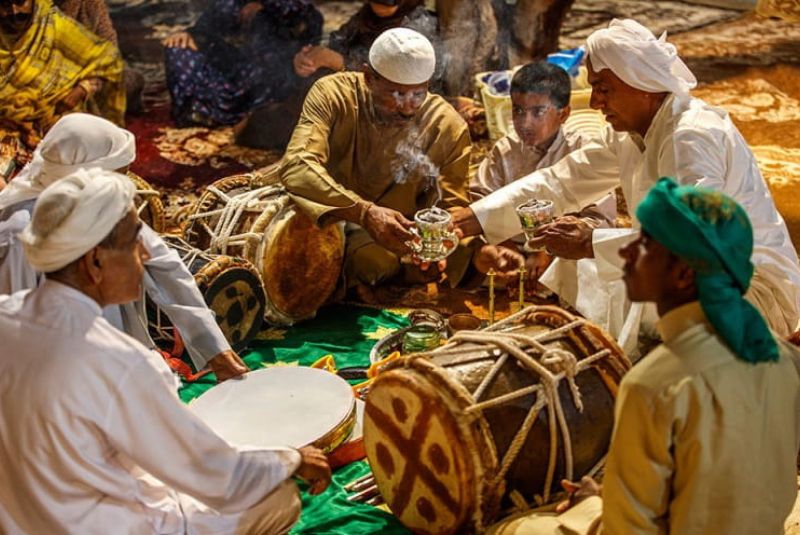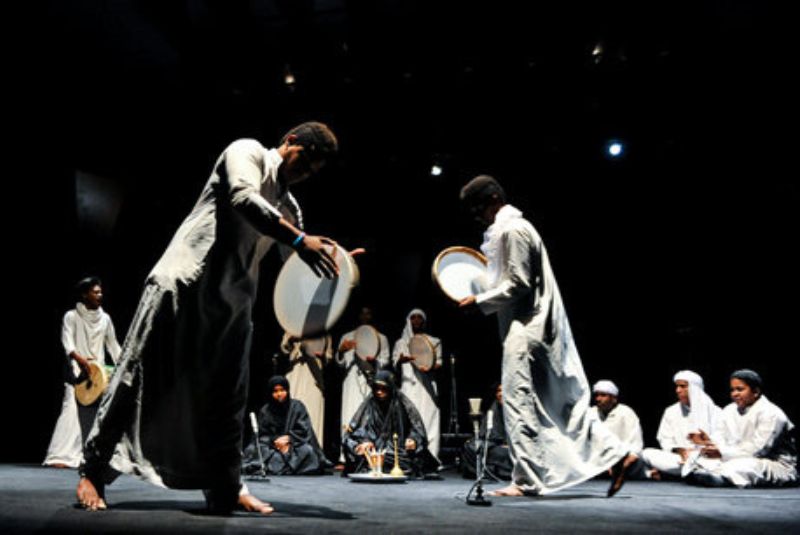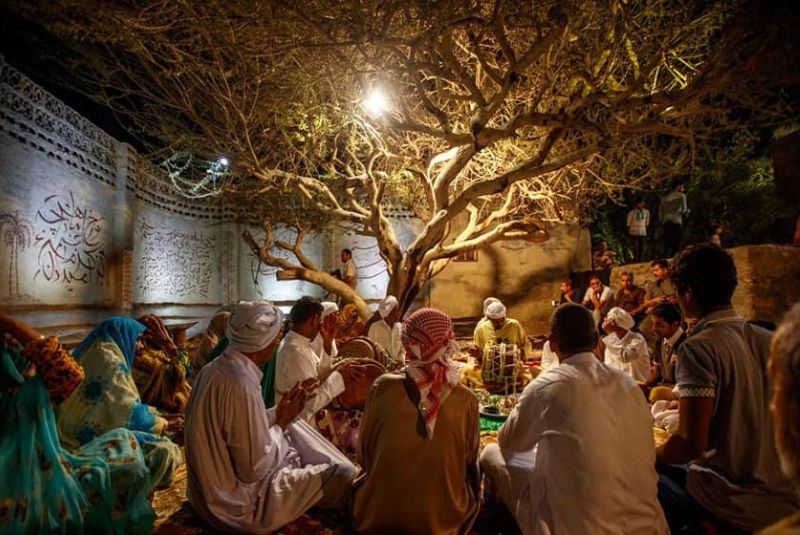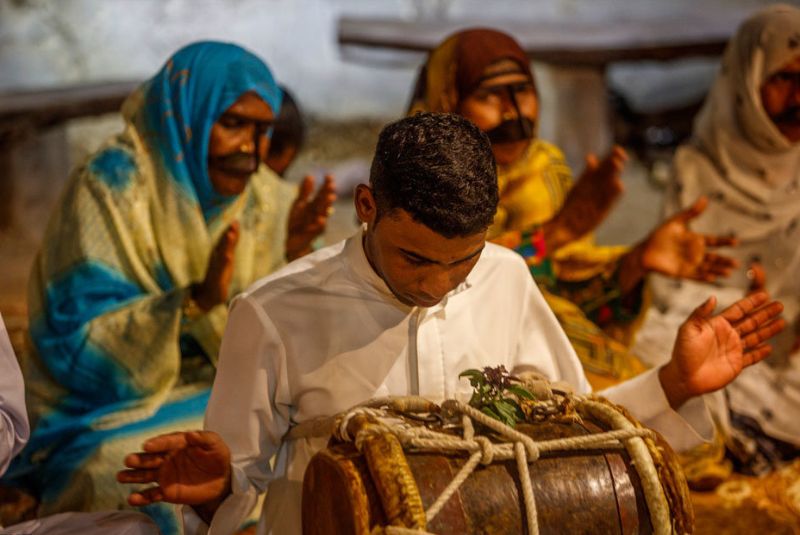Zar Ceremony in Hormozgan
Are you intrigued by the supernatural? Or Have you ever wondered about exorcism and the existence of spirits?
If you want to delve into a real-life horror experience and your curiosity knows no bounds, visit Hormozgan in Iran and experience the Zar ceremony.
"Zar Ceremony" is a spine-chilling ritual performed in the southern regions of Iran, particularly in Hormozgan and Qeshm Island. This ceremony aims to rid people of evil spirits and ghosts believed to inhabit their bodies.
According to local beliefs, an otherworldly wind or Jinn traverses the sea waves, penetrating human bodies in various ways along the southern coast. When conventional treatments fail, those who remain unwell are thought to have become "Havai," with a demon or ghost taking residence within them. To restore their health, the Zar ceremony is conducted, accompanied by music, creating a mesmerizing exorcism. While the Zaar ceremony originated in Africa, the Iranian rendition showcases its own distinctive style, setting it apart from North African traditions.
Join us as we unravel the mystique surrounding the Zaar Ceremony, exploring its rituals and the eerie ambiance that surrounds it.
What is Zar?

Zar, in the Persian language, signifies a state of chaos. In a figurative sense, it refers to a supernatural being found in the southern regions of Iran and along the Persian Gulf coastline.
In the southern regions of Iran, particularly Qeshm Island, there is a belief in the presence of winds that can be categorized as either vicious or peaceful, associated with being a believer (Muslim) or non-believer (infidel). The latter category, including Zar, is considered more dangerous.
According to local beliefs, individuals who fall ill and cannot be cured through conventional means are thought to be afflicted by genies or wandering souls. Consequently, special celebrations accompanied by music are organized to facilitate their healing.
| Discover: What is Zoroastrianism Religion? - Ultimate Guide
Who are the Ahl al-Hawa?
"Ahl al-Hawa" or members of the Hawa Family are those who have been hit by one of the winds and subsequently recovered through Zar ceremonies. Whoever joins the group of "Ahl-e Hava" should always be clean, wear clean and white clothes, not drink alcohol, and not do bad things because it may annoy the winds.
| Read more: Pahlevani and Zoorkhaneh Rituals - An Ancient Sport
Zar Ceremony Origin

The origin of the Zar ritual can be traced back to Ethiopia in North Africa. During the Zar ceremony, the organizers employ various techniques to induce a frenzied state among the participants. They play drums, dhals, or damams and burn a special incense known as Zar incense.
According to local beliefs, individuals who have fallen ill and have not responded to conventional treatments are thought to have become "Airy." This is believed to occur when a genie or wandering spirit enters their body. To address this, a special exorcism ceremony is conducted with accompanying music, aiming to help the person recover their health. It's worth noting that the Iranian Zar rituals differ considerably from those in North Africa.
| Suggestion: Sama Dance - Unraveling the Mystical Beauty of an Ancient Dance
Major and Famous Winds in Hormozgan
In Iran, there are various types of winds with distinct characteristics:
- Zar Wind: These winds are predominantly non-believers, commonly referred to as "Red Wind," with only a few exceptions.
- Noban Wind: This wind has the tendency to make individuals sick, immobile, and feel depressed.
- Mashayekh Wind: This wind category includes both safe and pure Muslim winds, as well as dangerous ones. They are often found abundantly along Muslim coasts.
- Genie Wind: These winds originate either from the earth's surface or underground. They are universally perceived as dangerous and harmful.
- Pari Wind: Pari Wind encompasses both unbeliever fairies and calculating fairies, both capable of infecting individuals. The wind fairy is considered infidel and poses a threat.
- Dib "Devil" Wind: Dib Wind, towering in height, targets people in deserts and islands, resulting in immediate death and desiccation.
- Giant Wind: This wind can be observed from a distance, resembling a swaying camel. Anyone caught in its path is destined for fatality.
Among these wind types, Zar, Noban, and Mashaikh Winds are more prevalent. Since the affected individuals do not perish immediately, they require the ceremonies and care provided by the "Ahle Hawa" community.
| Also might be interesting: How Iran Celebrates Christmas Eve?
Zar Ceremony Preparations

As we have mentioned, the Zar ceremony is performed when conventional treatments fail to heal an individual; they are brought to experts known as "Babazar" and "Mamazar." These experts possess the knowledge and skills to conduct rituals aimed at extracting jinns and spirits from the patient's body. Through careful examination, Babazar and Mamazar identify signs of being "Airy," indicating that demons and spirits have entered the person's body. And in that case, the Zar ceremony is considered the only effective method to cure such an infection.
To prepare for the Zar ceremony, Babazar or Mamazar keeps the possessed person secluded from the public eye for a duration of seven days. During this time, they administer special medicines and oils to the affected individual.
A pivotal aspect of the Zar ceremony revolves around the performance of Zar music, a unique and captivating form of music. It is believed by the local community that Zar music helps to elicit kindness from the Jinns, encouraging them to exit the patient's body.
During the ceremony, the patient's head is covered with a cloth, and others form a circle around them. Babazar, holding a bamboo broom, begins to sing while gently striking the patient with the broom in rhythm with the song. The patient moves their head left and right in synchronization with the beat of the music. Music plays a significant role in the ceremony, invoking a sense of lamentation. Each Zar ceremony has its distinct music and poetry, with the rhythm adapting to the style of the accompanying poetry.
| Discover: Sepandarmazgan - A Celebration of Love, Women and Earth
How the Zar Ceremony is Performed

To perform the Zar ceremony, several key steps and rituals are followed. Prior to the ceremony, a person known as "Khizrani" from Ahl-e-Hawa carries a Khaizran (Bambuseae Broom) and goes door-to-door, inviting the Ahl-e-Hawa community members to participate in the ceremony.
The venue for the ceremony is usually a special hall located at the center of the community, where Babazar and Mamazar, the ritual leaders, are positioned. Babazar sits on a stool behind a large drum called "Modendo," which is placed on a tripod. Adjacent to the Modendo, there are two other drums called the "gap-drum" and "kasar," forming a row. A silver tray or wash basin is placed in front of Modendo, where Geshte Souz (a type of incense) and Kandork (another type of incense) are burned. Babazar also smokes the Modendo.
Before the guests arrive, a table is prepared with various offerings. It includes a variety of food, fragrant herbs, southern basil, Konar fruit, dates, meat, and blood. The blood on the table is obtained from a sacrificed goat, beheaded during the gathering, and placed in a dish. Usually, the Zar does not speak until the blood is offered to it. The quality and quantity of the blood consumed serve as a measure of the severity and dependence of the affected person. The prestige and status of Babazar or Mamazar are based on the amount and frequency of blood consumption.
When a person is identified as infected or possessed by one of the Winds, they are secluded in a private area, away from others' sight, for seven days. The patient's body is cleansed, and they are prevented from seeing women, dogs, and chickens during this period. Only Babazar or Mamazar attend to the possessed person. Each night, a special potion or medicine is applied to the patient's body.
To expel the Wind or Jinns, the affected person is put to sleep, and their big toes are tied together with goat hair. Fish oil is placed under their nose, and strands of burning goat hair (or dog hair in some cases) are also placed under the nose. Babazar then threatens the Jinn with a bamboo broom, urging it to leave the possessed body. With gentle strikes on the patient's body, the Jinn leaves with great distress and screaming. After the Jinn's departure, the subsequent rituals, like performing specific songs, making vows, and continuing with blood offerings and sacrifices, focus on subduing the Wind.
| Suggestion: Mehregan Festival in Iran - Celebrate Autumn with Zoroastrians
Rules During the Zar Ceremony
During the Zar ceremony, various rules and guidelines should be followed by the patient, Ahle-hava (community members), Babazar, and Mamazar. Here are some of the important rules:
- Sobriety: It is crucial for all participants to refrain from becoming intoxicated.
- Prohibited Utterances: As Zar is associated with beliefs considered outside mainstream religion, it is forbidden to mention the name of God or prophets during the ceremony. Doing so may prevent the expulsion of the evil spirit from the patient's body.
- No Greetings: When entering the ceremony, individuals should avoid saying 'Salam' or exchanging greetings with others present. They must remove their shoes before entering and sit silently among the Ahle Hawa group without exchanging greetings.
- Guests should not engage in conversations with others present.
- Loud talking is strictly prohibited.
- Tea and Coffee Etiquette: If offered a cup of tea or coffee, you should not place your cups down after finishing tea or coffee. Instead, you should wait for someone to collect the cups.
| Read more: Mystical Essence of Anahita - Goddess, River, and Myth
Zar Music and Zar Dance

Zar music holds a prominent role in the Zar ceremony, serving as a form of music therapy during the rituals. It plays a crucial part in the process of engaging with the Jinns and spirits present within the affected individual.
One of the notable instruments used in the Zar ceremony is the Tanbureh. However, only Baba Zar and a select few individuals permitted by Baba Zar are allowed to play this instrument. During the ceremony, Baba Zar or Mama Zar leads the singing, accompanied by various musical instruments, creating a melodic atmosphere. The purpose of this musical performance is to encourage the Jinns to reveal themselves.
According to Baba Zar, each Jinn or Wind has a distinct name, and it is vital to invoke their real name. Holding a stick in hand, Baba Zar strikes the body of the possessed person, urging the Jinn to depart from their body and release them from its influence.
Zar music, combined with the rhythmic strikes and vocalizations of Baba Zar or Mama Zar, contributes to the overall experience of the ceremony. It is believed that this musical interaction and physical interaction with the possessed individual help in the expulsion of the Jinn and provide relief to the affected person.
Additionally, it's worth noting that Zar music is often accompanied by Zar dance. The participants, including the possessed person, engage in specific dance movements and gestures that are believed to aid in the expulsion of the Jinns. Zar dance is characterized by rhythmic swaying, head movements, and coordinated steps, forming a synchronized expression of the music and the spiritual healing process.
| Also read about: Tirgan Festival - Water Festival in Iran from Ancient Times
Where is the Zaar Ceremony Held?
The Zaar ceremonies take place primarily in the Zinat Ritual Garden, which is located in Salakh village on Qeshm Island. This garden serves as the designated venue for hosting the rituals. It is open to the public, allowing visitors to witness and experience the unique cultural practices of the Zaar ceremony.
| Read more: Iranian's Common Traditions
Bottom Line
The Zaar ceremony in Hormozgan and Qeshm Island is a captivating ritual aimed at purging individuals of malevolent spirits and ghosts believed to afflict them.
It is deeply rooted in local beliefs, and this haunting ceremony addresses the presence of an otherworldly wind or Jinn that enters human bodies along the southern coast of Iran. It is usually performed to help sick people who have failed to recover using conventional treatments. It is accompanied by unique and bizarre rituals, including the zar music and the zar dance, which create a unique exorcism experience. While its origins trace back to Africa, the Iranian Zar ceremony showcases its own distinct style, making it a fascinating cultural phenomenon in the region. If you have always wanted to experience real-life exorcism, here is your opportunity to witness it at the Zar Ceremony in Hormozgan.
Share your story!
Comment below and let us know about your Experience.
Your story inspires others!


Comment
Leave a Comment